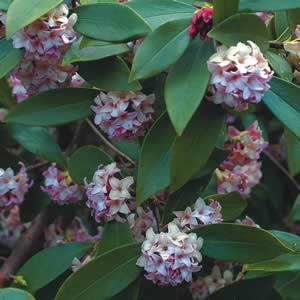Daphne Growing Guide

What is Daphne?
Daphne (Daphne odora) is an upright evergreen shrub. It is part of the Thymelaceae family and is native to China and Japan. Daphne is generally a neat and compact plant that has dark green, leathery leaves. Daphne species vary in habit – some are erect, while others are rounded or even spreading. They flower from mid Winter until late Spring. Pink buds form before opening to reveal fragrant, waxy flowers. Flower colours vary depending on variety and can be white, cream, yellow or pink. Daphne does best in cool to temperate climates where they like morning sun or an easterly-facing spot in the garden. They need full sun to light shade that has protection from hot afternoon sun. Daphne hate having their roots disturbed, so choose your spot carefully when planting. They are a slow growing plant.
Benefits of Growing Daphne
Daphne is a great plant for a cottage or a scented garden. Plant in a garden that is near a window or door to allow the sweet fragrance to waft inside the house. Daphne also grow well in containers. They make a great cut flower.
How to Grow Daphne
Climatic Zones
Cool, temperate.
Plant Size
Height: 1m, Width: 1.5m
When To Plant Daphne
Plant anytime.
Soil Preparation
Daphne like a humus rich, well drained, acidic soil. If you have heavy clay soil, add compost or bark before planting to help with drainage.
How To Plant Daphne
Plant in full sun to part shade, 90cm apart with the plant crown at soil level. You can plant them closer together as they are slow growing to get an immediate effect. No closer than 50cm.
They have fragile roots so do not tickle them out when planting.
Daphne Plant Care
Water to establish, then only if rainfall is low. They dislike having wet feet as this can cause root rot. Allow the Daphne to dry out after watering before watering again.
Mulch to retain moisture in the soil and suppress weeds.
Use some slow-release fertiliser each Spring. Look out for leaves that are light green, and that hang down. This indicates the plant might need a feed. Feed with a light sprinkling of blood and bone every two or three months in growing/flowering season.
Trim off flower heads (good for indoor cut flowers) which will promote a bushier growth. Prune to shape.
Root rot can be a problem due to over watering.
Watch out for Aphids and scale.







